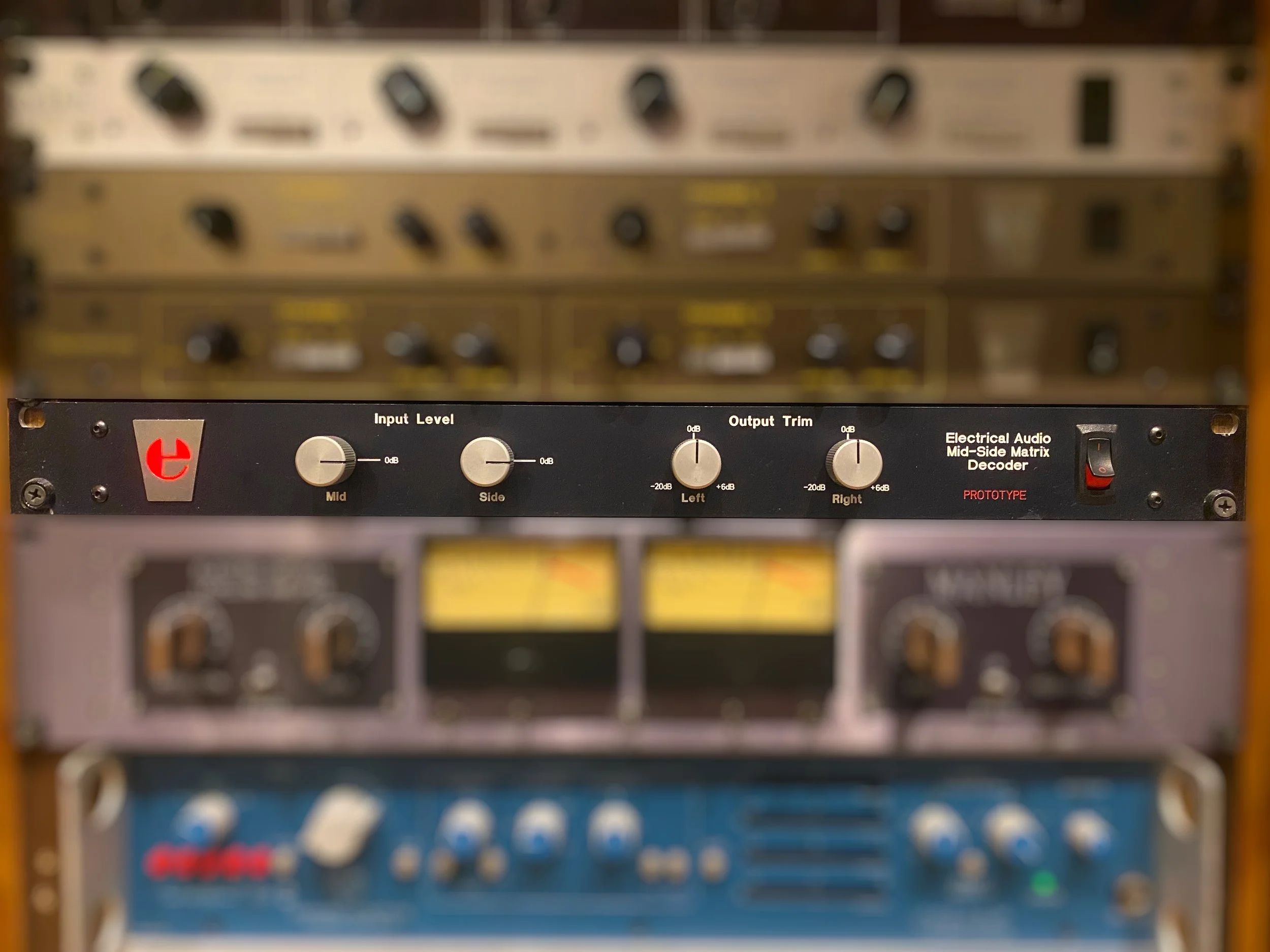The M-S Matrix eliminates the need for eating up console channels to decode mid-side signals.
Typically you would use one channel for the “mid” signal (panned center), and two for the “side” (one panned left, the other panned right, with the polarity reversed). The need to have both side channels precisely set to the same gain makes it difficult to adjust the stereo width easily. Our Matrix makes that simple to do with just one knob (“Side”). This unit can also be used to create sum-and-difference signals.
If you are interested in owning one, we do sell these directly. Contact us for more information.
How to Use
For basic stereo recording, position the Mid microphone in front of, and facing the subject. This microphone can be omnidirectional or directional. If directional, make sure that it points to the center of the desired stereo field. Position the Side microphone as close as possible to the Mid microphone, making them a “coincident pair”. The Side microphone must have a bi-directional (figure-8) pattern. The front of that microphone (phase-positive) should be pointed 90° to the left. You can choose, for example, whether this will be the performer-perspective left or the audience-perspective left at this point. Stereo multi-pattern microphones (like AKG c-24, Neumann SM-69, SM-2, SM-23…) are ideal for this, but not necessary.
Connect the M-S microphones to microphone pre-amplifiers, as you normally would. Send the pre-amplifier outs to the Matrix inputs. If using a console, you may use the Mid-Side Matrix on the channel inserts. Be aware of the relative position of the channel equalizers with respect to the insert point if you intend to equalize the signal. The Mid and Side gain should start off at the “0dB” mark, and the output trims should be set to unity gain (12 o’clock). You can then use the output trim pots to balance out the Left/Right levels. If you wish to adjust the stereo width, lower the Side gain for a more mono image, or raise it for a wider stereo image. You can tell if you have too much Side signal if you mono your monitor and the apparent volume drops. It is important that the levels coming from your preamp are roughly at studio nominal level (+4dBu). If the decoder is to be plugged into -10dBV equipment, use the output trims to lower the signal.
Some tips for using the M-S decoder (Steve):
If the stereo signal needs to be equalized, there are a number of choices available with an M-S signal. The output of the matrix may be equalized with any stereo equalizer, of course, but there are other options as well.
If the signal needs to be brighter, for example, but the stereo width is unduly exaggerated by using a stereo equalizer (in the case of a percussion table or drum kit recording, for example, where cymbals or other instruments may be on opposite sides of the stereo field), then the Mid signal can be equalized (with the equalizer in-line ahead of the matrix input) instead of the stereo output. This will make the center portion of the image brighter, while leaving the far edges of the L-R image less affected
To widen the stereo image in the treble range without making the center information brighter or generally widening the stereo image (on another drum kit recording, where the signal is too narrow, but the bass drum is at an appropriate volume and sounds good centered), the Side signal can be equalized instead.
If using compression on a stereo signal, compressing the Mid and Side components prior to matrixing will ensure perfect stereo tracking. This allows the use of two mono compressors if no stereo unit is available, and ameliorates the slight differences between channels in stereo units.
It is also possible to dynamically widen or narrow the stereo image. To widen the image with increasing volume, compress or limit only the center channel. This can increase the impact of a dramatic dynamic entrance, for example, or provide a dynamic widening effect in time with the music. To dynamically narrow the stereo image, use a limiter on the Side signal. This can prevent signals at the extreme edges of the stereo field from becoming distracting when they appear suddenly, or lessen a momentary left-right imbalance.
If a limiter with fast attack and slow release is used on the side signal, the gradual widening of the stereo image on long-decaying sounds (piano, ambient acoustic instruments, drums and cymbals, etc.) can be achieved. This is a unique effect, and difficult to achieve in any other way.
The Mid-Side Matrix Decoder has approximately 7dB of total gain available, and in certain situations can allow the microphones to be used as input sources without mic pre-amplification. For example, the outputs of an AKG C24 stereo microphone, or any similar active (powered) microphone, can be patched directly into the Mid and Side inputs. In front of loud sounds (drum kit, for example), the gain of the Mid-Side Matrix Decoder can be enough for proper recording levels. This method avoids several potential noise and fault sources. The input impedance of the Mid-Side Matrix Decoder is 50k Ohms, and should not negatively affect any normal microphone output (nominal output impedance of 500 Ohms or less).


